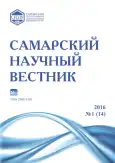Временные бюджеты дневной активности жуков-листоедов (Coleoptera, Chrysomelidae) на разных этапах их генерационного цикла
- Авторы: Павлов С.И.1
-
Учреждения:
- Самарский государственный социально-педагогический университет
- Выпуск: Том 5, № 1 (2016)
- Страницы: 47-51
- Раздел: 03.02.00 – общая биология
- URL: https://journals.rcsi.science/2309-4370/article/view/21964
- DOI: https://doi.org/10.17816/snv20161110
- ID: 21964
Цитировать
Полный текст
Аннотация
В течение 1974–2010 гг. в природных и лабораторных условиях в Самарской области изучались нативные (естественные) двигательные реакции активных жизненных фаз (имаго и личинок) 4-х видов жуков-листоедов (Coleoptera, Chrysomelidae), имеющих 1-годичную генерацию. В зависимости от доминирующей на каждом этапе онтогенеза «биологической программы», типа двигательной активности (набора конкретных движений) и временных бюджетов реализации этих движений, весь генерационный (репродуктивный) цикл был разбит на 4 этапа – функциональных блока поведенческих реакций. К ним были отнесены – прекопуляционный период (время созревания имаго), этап копуляции (спаривания взрослых жуков), этап овуляции (созревания и откладки яиц) и этап эмбриогенеза (отрождения и развития личинок). Рассмотрена динамика продолжительности светлого периода суток (когда листоеды деятельны) в течение всего генерационного периода. Вычислена продолжительность «полезного» времени светлого периода дня (для данной широты местности), т.е. астрономическая долгота дня за вычетом длительности утренних и вечерних сумерек (когда относительно холодно, выпадает роса и насекомые неактивны), именно тот период, когда листоеды наиболее подвижны. Подсчитаны реальные временные бюджеты двигательной активности в течение светлого времени суток на разных этапах генерационного цикла. Зарегистрированы и изучены основные типы двигательных реакций листоедов. Установлено, что таких реакций – 13, общих для всех этапов – 5, специфических – 8.
Полный текст
Открыть статью на сайте журналаОб авторах
Сергей Иванович Павлов
Самарский государственный социально-педагогический университет
Автор, ответственный за переписку.
Email: ci-pavlov@yandex.ru
кандидат биологических наук, доцент кафедры биологии, экологии и методики обучения
Россия, СамараСписок литературы
- Зайцев Ю.М., Медведев Л.Н. Личинки жуков-листоедов России. М.: ТНИ КМК, 2009. 246 с.
- Медведев Л.Н., Зайцев Ю.М. Личинки жуков-листоедов Сибири и Дальнего Востока. М.: Наука, 1978. 183 с.
- Медведев Л.Н., Павлов С.И. Репродуктивное поведение жуков-листоедов (Coleoptera, Chrysomelidae) // Зоологический журнал. LXIV, 8. 1985. С. 1168-1177.
- Медведев Л.Н., Павлов С.И. Брачное поведение жуков-листоедов (Coleoptera, Chrysomelidae) // Энтом. обозр., LXVI, 4. 1987. С. 746-753.
- Павлов С.И. Фауна и экология жуков-листоедов (Coleoptera, Chrysomelidae) Среднего Поволжья: автореф. дис. … канд. биол. наук. М.: ИЭМЭЖ им. А.Н. Северцова, 1985. С. 13-14.
- Caveney Stanley, Scholiz Clarke H., McIntyre Peter. Patterns of daily flight activity in onitine dung beetles (Scarabaeinae: Onitini) // Oecologia. 1995. 103, № 4. С. 444-452.
- Kersting U., Baspmar H. Seasonal and diumal flight activity of Circulifer haematoceps (Hom., Cicadellidae), an important leafhopper vector in the Mediterranean area and the Near East // J. Appl. Entomol. 1995. 119, № 8. C. 533-537.
- Landin Bengt-Olof. The diel flight activity of dung-beetles (Coleoptera, Scarabaeidae). A study of the influence of environmental factors, with particular reference to the light // Opuscula entomol. 1968. 31, Suppl. № 32. 172 pp.
- Chapman R.F. Observations on the flight activity of the red locust, Nomadacris septemfasciata (Serville) // Behaviour. 1959. 14, № 4. C. 300-334.
- Yerington A.P., Warner R.M. Flight distances of Drosophila determined with radioactive phosphorus. // J. Econ. Entomol. 1961. 54, № 3. C. 425-428.
- Чернышев В.Б. Время лета различных насекомых на свет // Зоологический журнал. 1961. Т. 40, № 7. С. 1009-1018.
- Weber Friedrich. Zur Tagaktivität von Carabus. // Arten. Zool. Anz. 1965. 175, № 4-6. C. 354-360.
- Horčičko Ivan. Diurnale Activität von Populationen Sitona lineatus (L.) (Col., Curculionidae). // Acta Univ. palack. olomuc. Fac. rerum. natur. Biol. 1981. № 21. C. 87-92.
- Ouiring Dan T. Diel activity pattem of a noctumal moth, Zelraphera canadensis, in natura // Entomol. exp. et appl. 1994. 73, № 2. C. 111-120.
- Hayashi Y., Isobe Y., Oishi T. Diel periodielty of emergence in a stonefly species, Sweltsa sp. (Plecoptera; Chloroperlidac) // 8th Int. Conf. Ephemeroptera, Lausanne-Fribourg, 14-18 Aug., 1995 and 12th Int. Symp. Plecoptera, Lausanne-Fribourg, 18-20 Aug. 1995: Programme and Abstr. Lausanne, 1995. C. 109.
- Белышев Б.Ф. Условия погоды и суточная активность стрекоз (Odonata) // Энтомологическое обозрение. 1967. Т. 46, № 4. С. 778-783.
- Turillazzi P.G., Zapponi G.A., Ricciardi C., Ceccarelli P. Analisidell’attivita’di locomozione e di grooming esibite da Periplaneta Americana posta in una nuova situazione ambientale (Blattoideat, Blattidae) // Fragm. entomol. 1976. 12, № 1. С. 113-125.
- Meng Hsiang-ling, Chang Kuang-hsüeh, Tu Sheng-lan, Ke Chia-yün. The activity rhythm and interspecies dominance of cotson bollworms. // Куньчун сюэбао, Acta entomol. sinica. 1973 (1975). 16, № 1. C. 32-38.
- Bailey Paul C.E. Diel activity pattern in larvae of the Australian caddisfly Helicopsyche murramba Mosely (Trichoptera: Helicopsychidae) // J. Austral. Entomol. Soc. 1982. 21, № 4. C. 247-250.
- Smith D. Courthey, Procopy Ronald J. Seasonal and diurnal activity of Rhagoletis mendax flies in nature. // Ann. Entomol. Soc. Amer. 1981. 74, № 5. C. 462-466.
- Лапшин Л.В. Сезонная активность доминантных видов жужелиц (Carabidae) в лесостепи Оренбургского Заволжья // Зоологический журнал. 1971. 50, № 6. С. 825-830.
- House H.L. The diel pattern of feeding activity of larval Pseudosarcophaga affinis (Diptera: Sarcophagidae). // Canad. Entomologist. 1969. 101, № 4. C. 409-412.
- Наумов Н.П. Экология животных: учеб. пособие для гос. ун-тов. М.: Высш. школа, 1963. С. 262.
- Бей-Биенко Г.Я. Общая энтомология: Учебник для ун-тов и сельхозвузов. 3-е изд. М.: Высш. школа, 1980. С. 132-136.
- Воронцов А.И. Лесная энтомология: Учебник для вузов. 3-е изд. М.: Высш. школа, 1975. С. 67-68.
- Особенности строения и поведения насекомых / Ред.-сост. Т.Д. Жданова. М.: Мир, 2004. С. 88-115.
- Павлов С.И. Ритуал «ухаживания» как необходимый инструмент, запускающий репродуктивный процесс насекомых // Вестник Волжского ун-та им. В.Н. Татищева. 2015. № 4(19). С. 298-305.
- Павлов С.И. Этолого-экологические адаптации в процессе проявления превентивной заботы о потомстве у жуков-листоедов (Coleoptera, Chrysomelidae) // Вестник Волжского ун-та им. В.Н. Татищева. 2011. № 12. С. 72-78.
- Чернов Ю.И. Природная зональность и животный мир суши. М.: Мысль, 1975. 222 с.
Дополнительные файлы







